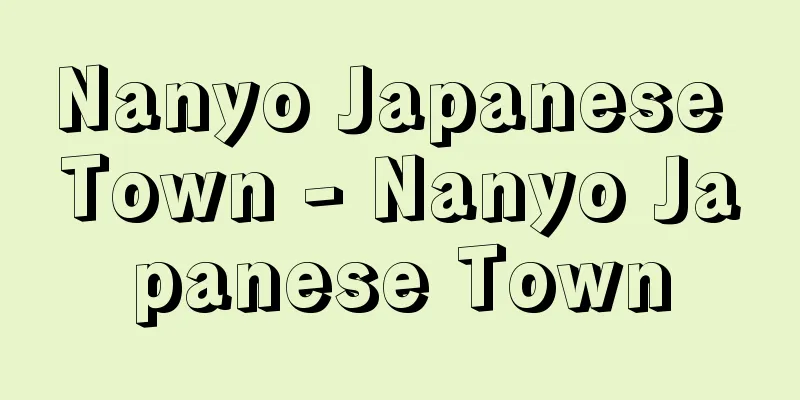Nanyo Japanese Town - Nanyo Japanese Town

|
From the beginning of the 17th century to the end of the century, Japanese settlements were formed in various parts of Southeast Asia. The number of Japanese traveling abroad had already been increasing since the end of the 16th century, but it became even more popular with the establishment of the Shuinsen system, and continued until the country was isolated. The destinations were Kochi (present-day central Vietnam), Siam (Thailand), Luzon (Luzon Island in the Philippines), Cambodia, Tokyo (Tonkin, present-day northern Vietnam), and Takasago (Taiwan), in order of popularity. The Japanese who traveled abroad were a variety of people, including pirates, sailors, merchants, the unemployed, and exiled Christians, and some traveled on foreign ships as employees of foreigners. The total number of Japanese who left Japan during this period is said to have been more than 100,000. Some of these travelers remained in the local area, and when the population was large, they created Japanese-only settlements in specific areas. These were called the Nanyo Japanese towns, and there were seven in total, roughly according to the frequency of red seal ship voyages: Feifo (now Hoi An) in central Vietnam, Tulan (Da Nang), Ayutthaya in Thailand, Dilao and San Miguel on the outskirts of Manila on Luzon Island, and Phnom Penh and Pinharu in Cambodia. There were also at least 20 other cases of Japanese people living among other peoples south of Macau, and they were found in almost all of Southeast Asia. The estimated population of the Japanese towns at their peak was 3,000 in the outskirts of Manila, 1,500 in Ayutthaya, and a total of more than 5,000 people in all seven Japanese towns. In most cases, the Japanese towns were given autonomy, and a Japanese person was chosen as their leader. This was a measure taken by the local government due to differences in language, customs, and laws. In places where Japanese towns were not formed (for example, Jakarta and Arakan in Ternate, Maluku Islands (now Myanmar)), leaders were chosen for the convenience of Japanese rule. The prosperous Japanese town was cut off from the arrival of red seal ships due to the strengthening of the overseas travel ban under the series of isolationist orders, and the supply of new human resources from the mainland was cut off. In addition, those who had stayed overseas for many years were punished by death if they returned to Japan, so they were unable to return home. Although the Japanese formed complicated intermarriage relationships among themselves, they were gradually absorbed into the local society. However, according to Dutch records, it is known that some Japanese people lived in three places, Feifo, Ayutthaya, and Dilao, from around 1690 to 1708. It seems that communication with Japan was relatively free, and so-called Jagatara letters remain, written by a mixed-race woman, Jagatara Ohharu, who had been banished from Nagasaki and lived in Jakarta until around 1697, and other women, to their hometowns. → Yamada Nagamasa → Related topics Ayutthaya Dynasty | Dilao Source : Heibonsha Encyclopedia About MyPedia Information |
|
17世紀初めごろから同世紀末近くまで,東南アジア各地に形成された日本人居留民の町。日本人の海外渡航はすでに16世紀の終りごろから増加していたが,朱印船制度の確立とともにいちだんと盛んとなり,鎖国まで続いた。行先は交趾(現在のベトナム中部),暹羅(タイ),呂宋(フィリピンのルソン島),柬埔寨(カンボジア),東京(トンキン。現在のベトナム北部),高砂(台湾)という順位であった。渡航者は海賊,船員,商人,失業者,追放キリシタン等さまざまであり,また外国人の雇人として外国船で渡航した場合もあり,この期間に出国した日本人総数は延べ10万人以上といわれる。彼ら渡航者の一部は現地に残り,人口の多い場合は特定の地域に日本人だけの集落をつくった。これが南洋日本人町と呼ばれるもので,だいたい朱印船渡航の頻度に応じて,ベトナム中部のフェイフォ(現在のホイアン),トゥーラン(ダナン),タイのアユタヤ,ルソン島のマニラ郊外にあるディラオとサン・ミゲル,カンボジアのプノンペンとピニャールーの合計7ヵ所。ほかに他国人の間に分散して住む例がマカオ以南に少なくとも20ヵ所あり,ほとんど東南アジアの全域に及んでいる。日本人町の最盛期の推定人口はマニラ郊外の3000人,アユタヤの1500人をはじめ,7ヵ所の全日本人町で総計5000人以上に達したようである。日本人町は多くの場合,自治権を与えられ,その頭領には日本人が選ばれた。これは言語,習慣,法律などが違うために現地政府側がとった処置であった。また日本人町を形成しなかった各地(たとえばジャカルタ,モルッカ諸島のテルナテ(現ミャンマー)のアラカン)でも日本人統治の便宜上,頭領が選ばれていた。繁栄した日本人町も一連の鎖国令による海外渡航禁令の強化に伴って,朱印船が来航しなくなり,内地からの新しい人材の供給を絶たれ,また海外に長年滞在した者は帰国すると死罪に処せられるので,帰国することもできず,日本人同士の間で複雑な姻戚関係を結んでいたが,しだいに現地社会の中に吸収されていった。しかし,オランダの記録によれば,フェイフォ,アユタヤ,ディラオの3ヵ所には1690年―1708年ごろまで何人かの日本人が生存していたことが知られる。日本への通信は比較的自由であったらしく,長崎から追放されてジャカルタで1697年ごろまで生きていた混血女性〈ジャガタラお春〉その他の女性が故郷に宛てたいわゆるジャガタラ文が現存。→山田長政 →関連項目アユタヤ朝|ディラオ 出典 株式会社平凡社百科事典マイペディアについて 情報 |
>>: Araucaria cunninghamii; hoop pine; Moreton Bay pine
Recommend
Sykes, GM
...D. Matza's "Drifting Theory of Delinq...
The Legend of the White Snake
A Chinese folktale. Also known as "Leifeng Pa...
Writing out - Writing out
In paleography, this refers to the beginning of a...
The Emperor's Declaration of Humanity - Tennouningensengen
Emperor Showa issued this Imperial Rescript on Ja...
Hess, GH (English spelling) HessGH
…Thermochemistry and electrochemistry were the fi...
Tosefta
...The period from the beginning of the 1st centu...
Quantum mechanics
In order to understand the phenomena of atoms, mo...
Magnolia campbellii (English spelling) Magnoliacampbellii
…[Kunihiko Ueda]. … *Some of the terminology that...
Kuhn, Abraham
…From the late 19th century to the early 20th cen...
A play about raincoats and swords
…He mixed tragic and comical elements, respected ...
Kasadomaru Group
...Furthermore, in 1924, the United States enacte...
Means of harming the enemy
It refers to combat actions taken by a belligerent...
Keeling
...An Australian island group located 2,768 km no...
Cafe Cantante - Cafe Cantante
...After the 15th century, gypsies came to Spain ...
Szabó M.
Other writers of the same generation include Mold...









